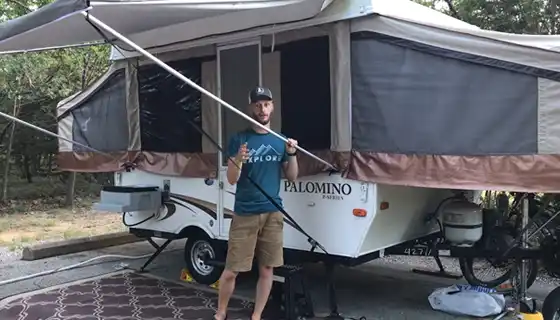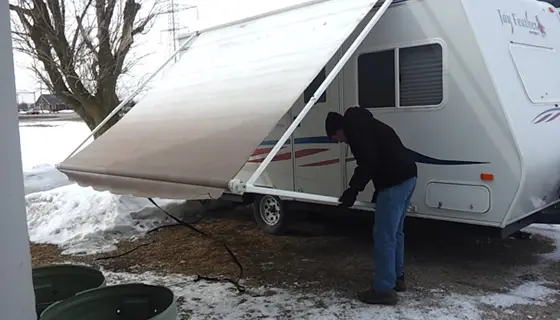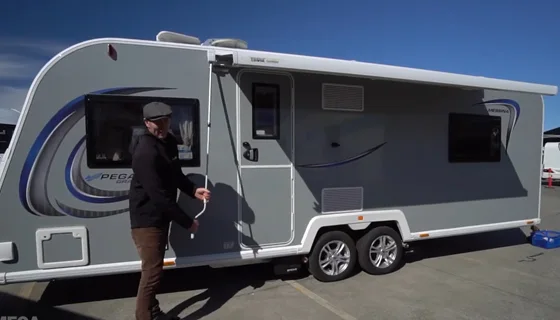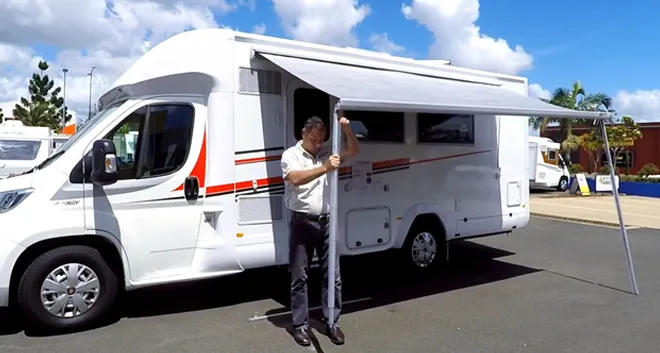Last Updated on April 20, 2023
Most RV awnings have a pull strap that must be pulled tight to unfold or retract the awning. But one of the most laborious tasks is opening and closing the awning without any strap-in, a manual or non-motorized RV retractable awning.
Opening and closing a manual awning can be tedious, and it is often easy to damage the awning if it is not done correctly. So if there is no strap to help pull it out, be mindful of how to open an RV awning with no strap for awning safety.
Opening an RV awning without using a pull strap might be easy once you know how to do it. But if your awning doesn’t have a strap, it can be hard to extend and close. Here’s a quick guide on opening an RV awning without a strap.
How to Open an RV Awning with No Strap in Simple Steps?

One problem you may encounter while RVing is opening your awning with no strap. This situation can arise if the pull strap breaks, you lose it while traveling, or you accidentally retract the strap with the awning. While it may seem like a difficult task, extending an awning without a strap is relatively easy if you follow these simple steps:
Step 01. Locate the Two Arms of the Awning
Before opening your RV awning, it is paramount to find its arms. They are typically located on either side of the RV awning, near the top. These spring loaded arms provide stability when it is closed.
Also, they are used to open and close the awning. If you want to open your RV patio awning without a pull strap, you must operate these arms carefully; otherwise, you may damage your awning & may cause serious injury.
Step 02. Release the Locks on the Awning Arms
Now that you have located the awning’s two arms, it is time to release the locks. Depending on the model of your RV, there may be one or two locks on each awning arm.
To remove the locks, simply push in on the button or lever and pull the RV awning arm down. Consult your RV’s owner’s manual if you can’t find the locking lever. This will help you locate them quickly and easily. Once both locks are released, proceed to the next step.
Step 03. Pull the Two Arms Down at the Same Time
Holding both of your arms together, gently pull them down. This can be accomplished by standing on each edge of the awning and grabbing each arm near the bottom.
If the awning is enormous, you might need others’ help to do this. To do this, ask your friends or family for help. Once both arms are free, pull them simultaneously down to the forward.
Both arms must be moving simultaneously, which will help prevent the awning from becoming unbalanced and collapsing. If one awning arm begins to move faster than the other, simply adjust your grip and continue pulling until both arms are fully extended.
Step 04. Fully Extend the Awning
When opening an RV awning, you must fully extend the awning before attaching the straps fully. This prevents the top from getting damaged or caught on something as you open it.
If you are having trouble completely extending the awning, gently push up on the arms until it is fully open. Once the awning is open, check to ensure that all the RV awning fabric is adequately positioned and secure. Now you can move on to the next step.
Following these simple steps, you can easily open your RV awning without a strap. Even though it seems complicated, it is pretty easy to do. Make sure you follow the instructions carefully and take your time.
Why is an RV Awning Strap Necessary to Open & Close It?

An RV awning strap is necessary when opening and closing your RV awning from an awning roller tube. The strap helps hold the awning in place while you open or close it.
A good quality strap will help keep the fabric tight, which can damage the awning or cause it to come loose. Also, a strap prevents the awning from flapping in the wind when it’s extended, preventing it from being pulled out of its brackets by strong gusts of wind.
Many people make the mistake of thinking that they can just pull the awning open or shut it without using a strap. However, this can damage the RV awning fabric and hardware. A strap ensures the awning is opened and closed smoothly, without any unnecessary material stress.
The Consequences of Opening an RV Awning Without a Strap

Opening an RV awning lacking a strap is not encouraged, as it can lead to severe accidents or injuries. Any experienced RVer knows that opening an awning without first securing it with a pull strap can have disastrous consequences.
Without the strap, the awning can easily be caught by a gust of wind and torn from its mounting, causing extensive damage to the RV itself and potentially injuring anyone nearby.
Moreover, the sudden release of the awning can send debris flying, which can break windows or damage other property. If the awning is not adequately pulled out with a pull strap before it is opened, it can collapse suddenly, trapping anyone underneath it. For these reasons, it is essential to use a strap to open an RV awning to avoid any potential harm.
Attaching a New Awning Strap
A new awning strap may be needed if your old one tears off. After opening your RV awning, you may need to attach a new strap if you do not have one already. Be sure to clean the area where the old strap was located. This will help to ensure that the new strap adheres properly.
To do this:
- The first step is to remove the old strap from the awning.
- Simply take the new strap and insert it through the awning’s fabric loops.
- Once the belt is in place, pull it tight and fasten it to the RV. You can make a pull strap using a ratchet strap in an emergency if you don’t have one.
- Simply tie the strap around the middle of the awning and secure it to the awning.
Now, when you open & close the awning, the ratchet strap will help hold it in place.
Open an RV Awning Without a Strap : Precautions to Take
One of the most important safety precautions when using an RV awning is to ensure it’s appropriately retracted via a pull strap. If the awning isn’t secured enough, a strong wind could cause it to collapse, which could damage the RV or injure anyone who happens to be underneath it.
Straps will also keep the awning from collapsing due to an unbalanced load. A few more safety precautions to take before utilizing an RV canopy that lacks straps include:
- Inspect the awning before using it. Ensure there are no rips or tears in the fabric and that all the hardware is secure.
- Do not attempt to open the awning if the weather conditions are not ideal. High winds, rain, and snow can stress the awning and lead to its breakdown.
- Do not stand underneath the awning while it is opening. If the top were to collapse, you could be seriously injured.
- Use caution when retracting and opening the awning. Be sure to hold onto both arms of the awning so that it doesn’t become unbalanced and collapse.
- If you use a rope or cord to pull the awning, ensure it is tied securely and not frayed.
- Do not leave the awning open and unattended without any strap. If you are not using it, be sure to close it, so it doesn’t become damaged or cause an accident.
Simply by following these safety precautions, you can use an RV awning without the use of a strap without any problems. Just be sure to take your time and take extra care when you open and close the awning.
FAQs
Let’s talk about some frequently asked questions about opening RV awnings without straps:
Q: Is it Safe to Use an RV Awning Without a Strap?
Many people believe that it is safe to use an RV awning without a strap, but this is not advisable. The straps are there for a reason, to provide additional support and stability when pulling out. You can easily damage an RV awning if you don’t pull out the awning straight. In the absence of the strap, the awning could become damaged or even detached from the RV, posing a serious safety hazard.
Q: How Do I Manually Retract My RV Awning Without a Strap?
If your RV awning is stuck in the retracted position and you don’t have a pulley, you can try manually retracting it. First, ensure that no debris or other objects are blocking the awning from moving. Then, grasp the fabric near the end closest to the RV. Apply pressure to the awning until it starts to move, then continue moving it till it is completely retracted. If you run into resistance, stop and check for obstructions again.
Q: Can You Use a Bungee Cord As a Replacement Strap For RV Awning?
Using a bungee cord is not recommended as an RV awning strap replacement. These cords are designed to stretch, which means they can become loose over time and may eventually come detached from the awning. Additionally, they can be damaged by UV rays and other elements, potentially causing them to break suddenly. This could lead to severe damage or injury. If your RV awning strap breaks, it’s best to replace it with a new one.
Q: How to Replace An RV Awning Strap?
If you need an RV awning replacement strap, there are a few things you’ll need to do. First, measure the length of the old strap and cut the new strap to match. Next, use a heavy-duty sewing needle to thread the new strap through the eyelets on the awning. Finally, tie a knot at each end of the strap to secure it in place. Or you can buy a new strap from hardware or an online store that sells RV parts and accessories.
Conclusion
Without a strap, an RV awning can be unsafe to open, so taking the necessary precautions before attempting to do so is essential. A continuous opening and closing of an RV awning lacking a strap are not advised either. The awning could get damaged, and it would be difficult to control. Using a strap to secure the awning before opening it is better. This will help prevent damage and make it easier to control the awning.
Following the simple steps outlined in this article about how to open an RV awning with no strap, you can open your awning safely and without any problems. Just be careful when extending and retracting the awning, and always use a strap when possible.



